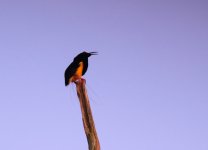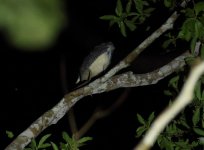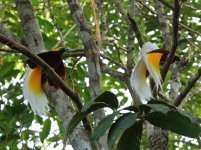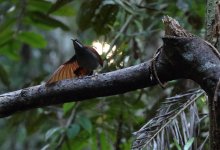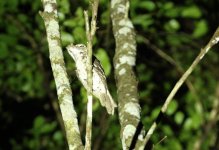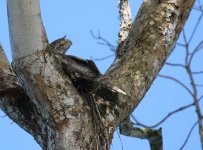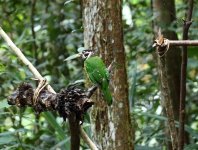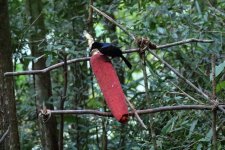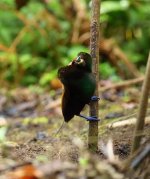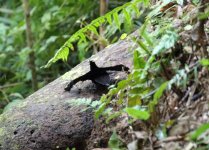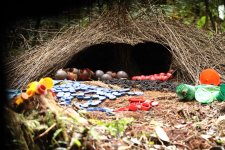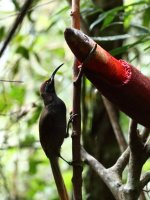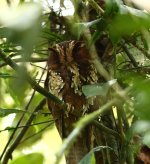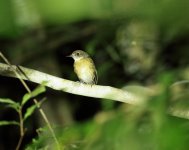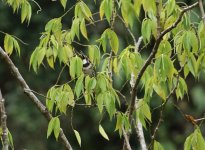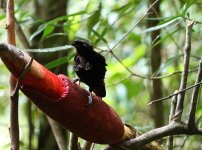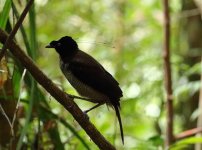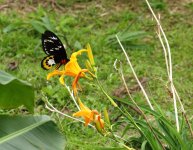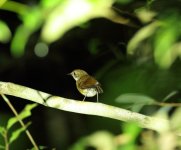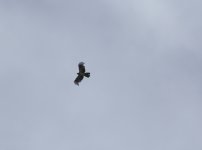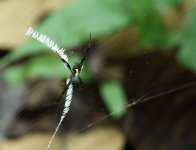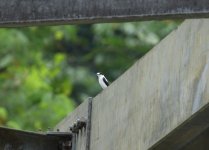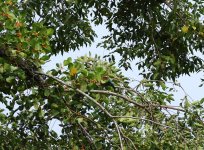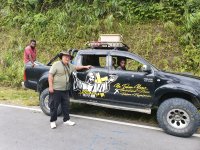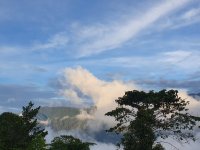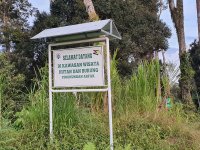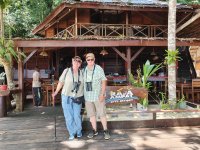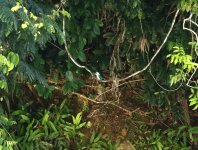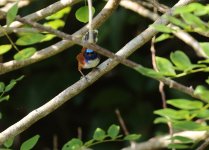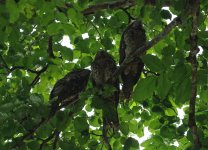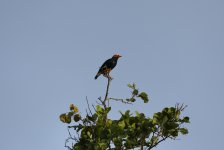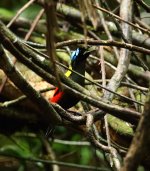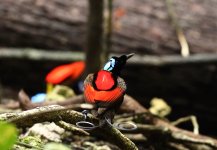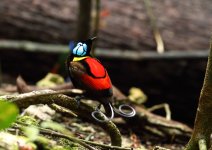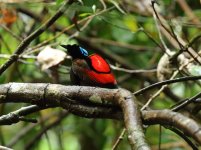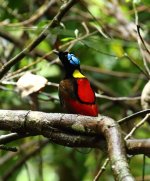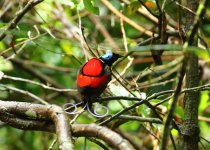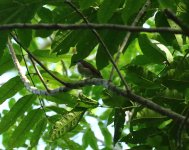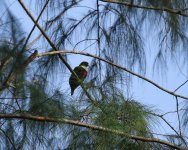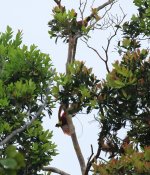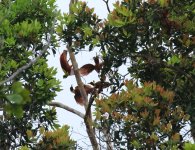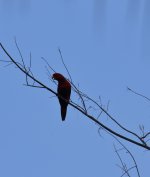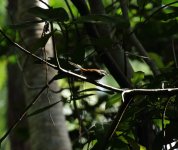I normally wouldn't do a trip report for an organised tour but it was suggested it might be useful even for people intending to do it with just local guides.
It was 10 years since we did Papua New Guinea as a full on birding trip with just local guides and lots of local hassle. We really wanted to do West Papua with a local guide but all the people we knew said that any decent local guides were being used by the Tour Groups as they catch up on Covid cancelled tours. So rather than wait for a guide until next year we decided to join an Easy Papua tour, I can say they aren’t very easy but there is limited camping / homestays and the mountain treks were just about manageable for all our group. I did look at three tours but in the end went for Zoothera who we had travelled with once before, but this was largely on the basis that tour was just over 2 weeks (other were up to 30 days) and it was visiting areas where I could get a number of new Birds of Paradise including Wilson’s and my main target Mottled Berryhunter a single species Genus I missed in PNG but also not spending a large amount of time in areas with huge overlap on birds we saw in PNG.
I worked out that we had a realistic possibility of between 75 and 100 new birds, a lot less than the people who had not been to New Guinea before. There was originally going to be 8 participants and 2 leaders (Nick Bray and Royke Mantanta) but the day before departure a couple caught Covid and had to withdraw so six only on the tour.
We flew from Manchester to Jakarta via Dubai (meeting Nick and Keith in Dubai airport) and then we had 6 hours in the airport hotel (in Terminal 2 E for Domestic which we had used before – booking a few weeks earlier than than the others on Booking.com got us a good rate). We met Heather and Geoff who flew from Dublin with Etihad in the hotel reception after a short sleep and a shower before we all headed to the Terminal. Nick had all the internal flight tickets and had got us extra leg room seats.
When we arrived in Jayapura we met up with Nigel (an Australian) and the last member of the group and Royke our local guide (he is Indonesian from Sulawesi and has his own company and is available for private tours next year). We had three cars / vans throughout and it worked much better than if we had, had 10 people squeezed in with equipment etc.
The plan did change based on Nick and Royke trip last month and on how things went on ours. Outline itinerary was on arrival in Jayapura, some local birding in Sentani plains then head up to birding camp near Nimbokrang for 5 nights (in the end we stayed 4 nights at the Camp then had a night at the Grand Hotel Sentani), then fly to Manokwari and drive in pick-ups into the Arfak Mountain where we stayed in a pretty basic homestay for 3 nights, I would have preferred a camp. We then flew to Sorong (staying a night in the same hotel before and after or trip to Waigeo) and then got the ferry to Waigeo from here, three nights on Waigeo but with one afternoon on a small island.
Having got into Indonesia – Visa on arrival worked fine and you can travel internally without the on-line app if you have a booster (they wanted paper copies of certs which we all had). You then do need to do a customs form on-line, there is wifi at Jakarta airport and then on arrival in Papua we had our paperwork checked and our details recorded but no need for additional documents like a Surat Jalan which some guide books still mention. We were off into the countryside and birding within an hour having decided not to have a hotel breakfast in the town as originally planned.
Day 1
The birds on the Sentani Grassland and near the lake weren’t exactly coming thick and fast but we did get Moustached Treeswift, Uniform Swiftlet, Pheasant Coucal, White-shouldered Fairy and our first lifer Black-billed Coucal, then while having breakfast at the lake we added White-bellied Sea Eagle, Little Black Cormorant, Great White Egret and then on the road a Sacred Kingfisher. Back in the Grassland we added Golden-headed Cisticola, Crimson Finch, Hooded Mannikin, Blue-tailed Bee-eater, Pacific Swallow and Tree Martin before a last bird of the morning a Variable Goshawk. Unfortunately our car wouldn’t restart so we travelled to the Bird Camp at Isyo Hills with the others a little cramped with our luggage coming later (I think people call it Alex’s camp). Camp was pretty OK accommodation with a Papauan Frogmouth sitting on the tree in the middle of a pool (missed that last time somehow).
Over lunch we saw Electus Parrot, Sulphur Crested Cockatoo and Olive-backed Sunbird but despite hearing it we just couldn’t find Buff-faced Pygmy Parrot. Nick wasn’t impressed with the guides here and they didn’t know of a single fruiting tree in the area. I have to say the local guides were probably worse than anywhere else we have been in in Indonesia or New Guinea. In the afternoon we had a serviceable car and we headed off to a viewpoint to hopefully see some common birds. We saw Black-capped Lory, Cococnut Lorikeet, Pinon and Zoe’s Imperial Pigeon, and then a few lifers for us Lowland Peltops, Long-billed Honeyeater, Black-billed Triller and Meyer’s Friarbird and then Mimic Honeyeater, White-bellied Cuckooshrike and Golden Monarch to add to the numbers. Last birds of the day as we stopped just before dawn were Yellow-faced Myna and then a couple of really close Papuan Nightjars that responded really well to calls.
Nimbokrang River
We headed out very early for a target bird for everyone. A local had told Alex the lodge owner that he had seen a Shovel Billed Kingfisher go into roost at the river. We headed out very early to get to the spot before first light. Unfortunately the bird was not exactly where he should be and we played hide and seek with him for 2 hours before all of us had good flight views in daylight and partial views in the thick vegetation in half-light but none of us managed a photo, still this was another huge target for us. We also heard Hook-billed Kingfisher and saw Rufous-bellied Kookaburra, only other bird of note was Ochre-collared Monarch. We decided to head up to the canopy tower where we had breakfast and then just watched a few birds go by or perch, we had Pinon Imperial Pigeon, Black-browed Triller, Yellow-bellied Longbill, Electus Parrot, Great Cuckoo Dove, Metallic Starling and Boyer’s Cuckooshrike before I spotted a final new bird for the morning a Northern Variable Pitohui.
After lunch we all headed for a Fawn-breasted Bowerbird bower, (except Nigel who was feeling a bit rough) we didn’t see the bird at the bower despite an hour wait but did see a few in the trees nearby. Other birds included Grey-headed Cuckooshrike, Shining Flycatcher, Variable Goshawk, Sacred Kingfisher and Black Sunbird before we headed back to the river to try for the Kingfisher again, and again only flight views but we did manage to draw in a Marbled Frogmouth to finish the day on a high.
Early morning walk to local hides.
The walk to the first 12 Wire BoP viewing point was only about 15 minutes up hill from the camp. We decided to give it a try as it avoided a drive and walk in wellies via a flooded area to the second known display site. The male 12 Wire BoP showed just before first light but didn’t display for very long and we saw no female so only shots I got were very high ISO record shots. We headed further up to a Lesser BoP lek but on the way (William the lead local guide did his only useful act of the 5 days) he spotted a Pale-billed Sicklebill out in the open but quite distant, this was the only one of this bird we saw although they were calling most of the mornings here. We then went to a large blind where we were able to view up to 9 Lesser Birds of Paradise we missed this in PNG as the viewing area was unsafe during the election period. We then went to see the King Bird of Paradise, display tree, we all saw male and female birds but views were quite distant and I was more excited by the Jobi Manucode another BoP to add to the list.
So a pretty good start to the morning and we headed to the canopy tower for breakfast. Only new bird to add from yesterday was Orange-fronted Hanging Parrot which was well spotted by Geoff and then scoped by us all.
I should have mentioned on the first day Sarah took to large bits out of her foot on the edge of the shower, I managed to dress it and keep it clean but she was struggling on a few walks and did decide to give a couple of sessions a miss to aid recovery. This afternoon was one of these as the main target bird was Emperor Fairywren which we had seen before. We went to an area called the “Irrigation Trail” and after some work we all saw a small group of Emperor Fairywren. There wasn’t a lot more to see we just added Moustached Treeswift, Papuan Spine-tailed Swift, Orange-bellied Fruit Dove and Red-cheeked Parrot before it started to get dark. We decided to go to a likely area for Papuan Hawk Owl and tried calling it, the call coming back was unusual but as none of us were experts we didn’t know what it was.
A few minutes later William asked us if we wanted to see a roosting Great-billed Heron, Nick, Heather and Nigel decided to carry on calling the Hawk Owl while the other three of us walked the few hundred yards in the dark. As soon as the spotlight was shone on the bird, all three of us said in unison Forest Bittern, Alex had mentioned earlier one had been seen in the morning near here, and I even got three record shots but with my camera settings all wrong. Nick and the others came quickly but as they arrived the bird flew and they didn’t get it. To say they were angry at William’s misidentification was an understatement particularly as he was still insisting it was a Heron until we showed him the photos. We never did get the Hawk Owl and Sarah wasn’t too despondent as she might have missed the bird by waiting back with the others in any event.
Magnificent Riflebird site
We were told this was quite a tricky 1 hour trail up to a display point and Nick’s last group had decided not to try for it. We were not ultra-keen as we had seen the bird before but as the forest was good for other target species we decided to go for it with the others. As expected the trail was muddy and slippy with quite a few climbs but Sarah managed well despite her sore foot and it was Nigel who struggled to keep up but we all made it to the viewpoints before daybreak (2 blinds with views of a fallen tree). The male bird displaying was immature and he didn’t have a full dance and pose but it was nice to see him calling and showing off but no females were around. However on the way down there was plenty to see, first Wompoo Fruit Dove, then Pinon’s Imperial Pigeon, Oriental Dollarbird, Blythe’s Hornbill, Yellow-billed Kingfisher which I finally photographed, Papuan King Parrot, before we heard and then I briefly saw a Papuan Pitta for some reason William felt he needed to make a blind and promptly chopped up and placed Palm branches from which we could look through at the place the Pitta had been, I was watching to the side of the blind as it got further away, no wonder they called him daft Rambo with his headband and propensity to use the machete at a moments notice. Despite trying to call the Pitta in only a couple of us got brief views that day. However we were quickly distracted when Nick heard a Jewel Babbler; a family that we had heard only (3 species on our last visit). Most of us got fleeting glimpses of the bird on the ground across a little stream but Nick saw a hill that he thought would get us decent views looking down on an area where two birds were coming and going but it was a jump and then a steep climb so only Geoff, Keith and I went for it and only Geoff and I got completely unblocked views of Blue Jewel Babbler, still we all saw the bird and also a White-bellied Thicket Fantail but Heather dropped her camera into the stream when trying to get it only for Geoff to move like lightning to get it out before it was completely drenched, after switching it off and leaving it for a few hours to dry it was OK. The birds kept coming we had Rusty Pitohui, Ochre-collared Monarch and Olive Flyrobin, Common Paradise Kingfisher fleetingly and before leaving we added a Grey Whistler.
After lunch we were going back to the view point but we learned that Nick and Geoff had seen a Spotted Cuscus from the canopy tower at lunchtime, so Heather, Sarah and I headed up to the tower with directions of where to look while the others went to the view point, we would join them later. Fortunately we found the Spotted Cuscus and saw a couple of birds Great Cuckoo Dove, Black-browed Triller, Metallic Starling and Spotted Dove. When we got to the viewpoint we were glad to learn we hadn’t missed anything and we had quite a quiet afternoon adding just Orange-bellied Fruit Dove, Purple-tailed Imperial Pigeon, Brush Cuckoo, Rufous-bellied Kookaburra, Palm Cockatoo, Red-cheeked Parrot and New Guinea Friarbird before seeing the Frogmouth active back at the lodge.
Other 12 wire viewing point
We drove early to the start of this trail and sure enough required wellingtons to get to the viewing area. We did see the male 12 Wire BoP but he wasn’t really using the display tree so views were less good than the first site. There were a few birds around the area but Yellow-faced Myna, Red-capped Flowerpecker, Lesser Bird of Paradise, White-bellied Cuckooshrike and Common Cicadabird were OK sightings. We had breakfast at a nearby bridge (KM12) and added Bar-tailed Cuckoo Dove, Oriental Cuckoo, Rufous-bellied Kookaburra, Golden Monarch, Olive-backed Sunbird, Streak-headed Mannikin, and Blue-tailed Bee-eater. We then went to a place called Jalan Korea for one target and quickly found Torrent Flyrobin and a Grey Wagtail.
We had decided to leave after lunch to give ourselves a good time at Sentani, we had a relax at the tower until 2 but Geoff and Heather still needed Grey Crow so they went to what had been an active nest a few weeks ago but unfortunately missed it. The grassland were much better in late afternoon, we soon saw Black-billed and Pheasant Cuckoo, then a couple of Brown Quail, which Nigel, Sarah and I got, the others took the wrong path but determined to flush them they went into the grass and flushed not only Brown Quail but King Quail. There were a selection of munias and we had Crimson Finch, Grand (great-billed) Mannikin, Hooded Mannikin and Chestnut-breasted Mannikin, I then called eagle and we all got on Pygmy Eagle (now split from Little).
We then headed to a place near the town of Sentani to see some Pigeons and Doves come in to roost, Heather and Nigel stayed in the car as they didn’t fancy the walk through the long grass, we didn’t get anything but close to the road we heard and then saw out in the open a Hook-billed Kingfisher, I gave up my chance a good photo to run and get Nigel and Heather as it was a lifer for them and I managed to get them to the bird before it flew further into the woods in now almost pitch darkness, my good deed for the day. We then stayed at the Grand Hotel Sentani and enjoyed warm showers, wifi and excellent food before our morning flight to Manokwari.
It was 10 years since we did Papua New Guinea as a full on birding trip with just local guides and lots of local hassle. We really wanted to do West Papua with a local guide but all the people we knew said that any decent local guides were being used by the Tour Groups as they catch up on Covid cancelled tours. So rather than wait for a guide until next year we decided to join an Easy Papua tour, I can say they aren’t very easy but there is limited camping / homestays and the mountain treks were just about manageable for all our group. I did look at three tours but in the end went for Zoothera who we had travelled with once before, but this was largely on the basis that tour was just over 2 weeks (other were up to 30 days) and it was visiting areas where I could get a number of new Birds of Paradise including Wilson’s and my main target Mottled Berryhunter a single species Genus I missed in PNG but also not spending a large amount of time in areas with huge overlap on birds we saw in PNG.
I worked out that we had a realistic possibility of between 75 and 100 new birds, a lot less than the people who had not been to New Guinea before. There was originally going to be 8 participants and 2 leaders (Nick Bray and Royke Mantanta) but the day before departure a couple caught Covid and had to withdraw so six only on the tour.
We flew from Manchester to Jakarta via Dubai (meeting Nick and Keith in Dubai airport) and then we had 6 hours in the airport hotel (in Terminal 2 E for Domestic which we had used before – booking a few weeks earlier than than the others on Booking.com got us a good rate). We met Heather and Geoff who flew from Dublin with Etihad in the hotel reception after a short sleep and a shower before we all headed to the Terminal. Nick had all the internal flight tickets and had got us extra leg room seats.
When we arrived in Jayapura we met up with Nigel (an Australian) and the last member of the group and Royke our local guide (he is Indonesian from Sulawesi and has his own company and is available for private tours next year). We had three cars / vans throughout and it worked much better than if we had, had 10 people squeezed in with equipment etc.
The plan did change based on Nick and Royke trip last month and on how things went on ours. Outline itinerary was on arrival in Jayapura, some local birding in Sentani plains then head up to birding camp near Nimbokrang for 5 nights (in the end we stayed 4 nights at the Camp then had a night at the Grand Hotel Sentani), then fly to Manokwari and drive in pick-ups into the Arfak Mountain where we stayed in a pretty basic homestay for 3 nights, I would have preferred a camp. We then flew to Sorong (staying a night in the same hotel before and after or trip to Waigeo) and then got the ferry to Waigeo from here, three nights on Waigeo but with one afternoon on a small island.
Having got into Indonesia – Visa on arrival worked fine and you can travel internally without the on-line app if you have a booster (they wanted paper copies of certs which we all had). You then do need to do a customs form on-line, there is wifi at Jakarta airport and then on arrival in Papua we had our paperwork checked and our details recorded but no need for additional documents like a Surat Jalan which some guide books still mention. We were off into the countryside and birding within an hour having decided not to have a hotel breakfast in the town as originally planned.
Day 1
The birds on the Sentani Grassland and near the lake weren’t exactly coming thick and fast but we did get Moustached Treeswift, Uniform Swiftlet, Pheasant Coucal, White-shouldered Fairy and our first lifer Black-billed Coucal, then while having breakfast at the lake we added White-bellied Sea Eagle, Little Black Cormorant, Great White Egret and then on the road a Sacred Kingfisher. Back in the Grassland we added Golden-headed Cisticola, Crimson Finch, Hooded Mannikin, Blue-tailed Bee-eater, Pacific Swallow and Tree Martin before a last bird of the morning a Variable Goshawk. Unfortunately our car wouldn’t restart so we travelled to the Bird Camp at Isyo Hills with the others a little cramped with our luggage coming later (I think people call it Alex’s camp). Camp was pretty OK accommodation with a Papauan Frogmouth sitting on the tree in the middle of a pool (missed that last time somehow).
Over lunch we saw Electus Parrot, Sulphur Crested Cockatoo and Olive-backed Sunbird but despite hearing it we just couldn’t find Buff-faced Pygmy Parrot. Nick wasn’t impressed with the guides here and they didn’t know of a single fruiting tree in the area. I have to say the local guides were probably worse than anywhere else we have been in in Indonesia or New Guinea. In the afternoon we had a serviceable car and we headed off to a viewpoint to hopefully see some common birds. We saw Black-capped Lory, Cococnut Lorikeet, Pinon and Zoe’s Imperial Pigeon, and then a few lifers for us Lowland Peltops, Long-billed Honeyeater, Black-billed Triller and Meyer’s Friarbird and then Mimic Honeyeater, White-bellied Cuckooshrike and Golden Monarch to add to the numbers. Last birds of the day as we stopped just before dawn were Yellow-faced Myna and then a couple of really close Papuan Nightjars that responded really well to calls.
Nimbokrang River
We headed out very early for a target bird for everyone. A local had told Alex the lodge owner that he had seen a Shovel Billed Kingfisher go into roost at the river. We headed out very early to get to the spot before first light. Unfortunately the bird was not exactly where he should be and we played hide and seek with him for 2 hours before all of us had good flight views in daylight and partial views in the thick vegetation in half-light but none of us managed a photo, still this was another huge target for us. We also heard Hook-billed Kingfisher and saw Rufous-bellied Kookaburra, only other bird of note was Ochre-collared Monarch. We decided to head up to the canopy tower where we had breakfast and then just watched a few birds go by or perch, we had Pinon Imperial Pigeon, Black-browed Triller, Yellow-bellied Longbill, Electus Parrot, Great Cuckoo Dove, Metallic Starling and Boyer’s Cuckooshrike before I spotted a final new bird for the morning a Northern Variable Pitohui.
After lunch we all headed for a Fawn-breasted Bowerbird bower, (except Nigel who was feeling a bit rough) we didn’t see the bird at the bower despite an hour wait but did see a few in the trees nearby. Other birds included Grey-headed Cuckooshrike, Shining Flycatcher, Variable Goshawk, Sacred Kingfisher and Black Sunbird before we headed back to the river to try for the Kingfisher again, and again only flight views but we did manage to draw in a Marbled Frogmouth to finish the day on a high.
Early morning walk to local hides.
The walk to the first 12 Wire BoP viewing point was only about 15 minutes up hill from the camp. We decided to give it a try as it avoided a drive and walk in wellies via a flooded area to the second known display site. The male 12 Wire BoP showed just before first light but didn’t display for very long and we saw no female so only shots I got were very high ISO record shots. We headed further up to a Lesser BoP lek but on the way (William the lead local guide did his only useful act of the 5 days) he spotted a Pale-billed Sicklebill out in the open but quite distant, this was the only one of this bird we saw although they were calling most of the mornings here. We then went to a large blind where we were able to view up to 9 Lesser Birds of Paradise we missed this in PNG as the viewing area was unsafe during the election period. We then went to see the King Bird of Paradise, display tree, we all saw male and female birds but views were quite distant and I was more excited by the Jobi Manucode another BoP to add to the list.
So a pretty good start to the morning and we headed to the canopy tower for breakfast. Only new bird to add from yesterday was Orange-fronted Hanging Parrot which was well spotted by Geoff and then scoped by us all.
I should have mentioned on the first day Sarah took to large bits out of her foot on the edge of the shower, I managed to dress it and keep it clean but she was struggling on a few walks and did decide to give a couple of sessions a miss to aid recovery. This afternoon was one of these as the main target bird was Emperor Fairywren which we had seen before. We went to an area called the “Irrigation Trail” and after some work we all saw a small group of Emperor Fairywren. There wasn’t a lot more to see we just added Moustached Treeswift, Papuan Spine-tailed Swift, Orange-bellied Fruit Dove and Red-cheeked Parrot before it started to get dark. We decided to go to a likely area for Papuan Hawk Owl and tried calling it, the call coming back was unusual but as none of us were experts we didn’t know what it was.
A few minutes later William asked us if we wanted to see a roosting Great-billed Heron, Nick, Heather and Nigel decided to carry on calling the Hawk Owl while the other three of us walked the few hundred yards in the dark. As soon as the spotlight was shone on the bird, all three of us said in unison Forest Bittern, Alex had mentioned earlier one had been seen in the morning near here, and I even got three record shots but with my camera settings all wrong. Nick and the others came quickly but as they arrived the bird flew and they didn’t get it. To say they were angry at William’s misidentification was an understatement particularly as he was still insisting it was a Heron until we showed him the photos. We never did get the Hawk Owl and Sarah wasn’t too despondent as she might have missed the bird by waiting back with the others in any event.
Magnificent Riflebird site
We were told this was quite a tricky 1 hour trail up to a display point and Nick’s last group had decided not to try for it. We were not ultra-keen as we had seen the bird before but as the forest was good for other target species we decided to go for it with the others. As expected the trail was muddy and slippy with quite a few climbs but Sarah managed well despite her sore foot and it was Nigel who struggled to keep up but we all made it to the viewpoints before daybreak (2 blinds with views of a fallen tree). The male bird displaying was immature and he didn’t have a full dance and pose but it was nice to see him calling and showing off but no females were around. However on the way down there was plenty to see, first Wompoo Fruit Dove, then Pinon’s Imperial Pigeon, Oriental Dollarbird, Blythe’s Hornbill, Yellow-billed Kingfisher which I finally photographed, Papuan King Parrot, before we heard and then I briefly saw a Papuan Pitta for some reason William felt he needed to make a blind and promptly chopped up and placed Palm branches from which we could look through at the place the Pitta had been, I was watching to the side of the blind as it got further away, no wonder they called him daft Rambo with his headband and propensity to use the machete at a moments notice. Despite trying to call the Pitta in only a couple of us got brief views that day. However we were quickly distracted when Nick heard a Jewel Babbler; a family that we had heard only (3 species on our last visit). Most of us got fleeting glimpses of the bird on the ground across a little stream but Nick saw a hill that he thought would get us decent views looking down on an area where two birds were coming and going but it was a jump and then a steep climb so only Geoff, Keith and I went for it and only Geoff and I got completely unblocked views of Blue Jewel Babbler, still we all saw the bird and also a White-bellied Thicket Fantail but Heather dropped her camera into the stream when trying to get it only for Geoff to move like lightning to get it out before it was completely drenched, after switching it off and leaving it for a few hours to dry it was OK. The birds kept coming we had Rusty Pitohui, Ochre-collared Monarch and Olive Flyrobin, Common Paradise Kingfisher fleetingly and before leaving we added a Grey Whistler.
After lunch we were going back to the view point but we learned that Nick and Geoff had seen a Spotted Cuscus from the canopy tower at lunchtime, so Heather, Sarah and I headed up to the tower with directions of where to look while the others went to the view point, we would join them later. Fortunately we found the Spotted Cuscus and saw a couple of birds Great Cuckoo Dove, Black-browed Triller, Metallic Starling and Spotted Dove. When we got to the viewpoint we were glad to learn we hadn’t missed anything and we had quite a quiet afternoon adding just Orange-bellied Fruit Dove, Purple-tailed Imperial Pigeon, Brush Cuckoo, Rufous-bellied Kookaburra, Palm Cockatoo, Red-cheeked Parrot and New Guinea Friarbird before seeing the Frogmouth active back at the lodge.
Other 12 wire viewing point
We drove early to the start of this trail and sure enough required wellingtons to get to the viewing area. We did see the male 12 Wire BoP but he wasn’t really using the display tree so views were less good than the first site. There were a few birds around the area but Yellow-faced Myna, Red-capped Flowerpecker, Lesser Bird of Paradise, White-bellied Cuckooshrike and Common Cicadabird were OK sightings. We had breakfast at a nearby bridge (KM12) and added Bar-tailed Cuckoo Dove, Oriental Cuckoo, Rufous-bellied Kookaburra, Golden Monarch, Olive-backed Sunbird, Streak-headed Mannikin, and Blue-tailed Bee-eater. We then went to a place called Jalan Korea for one target and quickly found Torrent Flyrobin and a Grey Wagtail.
We had decided to leave after lunch to give ourselves a good time at Sentani, we had a relax at the tower until 2 but Geoff and Heather still needed Grey Crow so they went to what had been an active nest a few weeks ago but unfortunately missed it. The grassland were much better in late afternoon, we soon saw Black-billed and Pheasant Cuckoo, then a couple of Brown Quail, which Nigel, Sarah and I got, the others took the wrong path but determined to flush them they went into the grass and flushed not only Brown Quail but King Quail. There were a selection of munias and we had Crimson Finch, Grand (great-billed) Mannikin, Hooded Mannikin and Chestnut-breasted Mannikin, I then called eagle and we all got on Pygmy Eagle (now split from Little).
We then headed to a place near the town of Sentani to see some Pigeons and Doves come in to roost, Heather and Nigel stayed in the car as they didn’t fancy the walk through the long grass, we didn’t get anything but close to the road we heard and then saw out in the open a Hook-billed Kingfisher, I gave up my chance a good photo to run and get Nigel and Heather as it was a lifer for them and I managed to get them to the bird before it flew further into the woods in now almost pitch darkness, my good deed for the day. We then stayed at the Grand Hotel Sentani and enjoyed warm showers, wifi and excellent food before our morning flight to Manokwari.
Attachments
Last edited:




